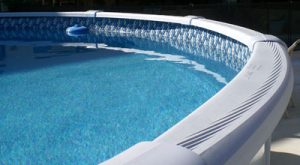Overlap-type liners are considered the “old type” of liner, but some still use them for their above-ground pools in Orlando.
With being an above-ground pool installer for 38 years, I remember when there were only overlap type liners for above grounds. Then the uni-bead and J-hook type came out and all but completely replaced the inferior overlap type.
Overlap liners would’ve drifted completely away (for standard above-ground pools) like the CD player, but Doughboy’s slow to grow with the times kept the overlap in play. They too eventually went almost entirely with unibead/j-hook types.
Overlaps have made a bit of a comeback though. This is because online retailers like Linerworld started selling a lot of liners made in China. And in the early years of China making liners for above-ground pools, they only made overlap-types
I’m not a fan of overlap-type liners to begin with, but with the market getting a bunch of these cheaply-made Chinese overlap-type liners that would only last a year or two, I was especially annoyed.
Chinese-made liners have gotten a little better over the years, but I still never recommend getting one as they don’t last nearly as long as one made in North America.
5 THINGS TO KNOW ABOUT INSTALLING AN OVERLAP-TYPE LINER IN ORLANDO
1 Overlap liners need coping strips
This type of liner is set on the inside of the pool and then the excess of liner is pulled over the wall and hangs over the outside. This is why it’s called an “overlap” liner.
The part of the liner that hangs over the top of the wall must be secured by long plastic strips called “coping strips”.
Coping strips can dry out and get brittle. When that happens, you will need new strips when replacing an overlap liner.
NOTE: You will not find coping strips for sale in Orlando. You will have to order them online.
2 Overlap liners can be used for 48”,52”, and 54” height walls
A standard overlap liner made in the US or Canada will have 60 inches (or five feet) of material that makes up the sides of the liner. (Chinese-made overlaps can have less)
This means that you can use the same liner for all above-ground pool wall heights.
3 If the liner has a pattern, you should make it consistent at the top
Since an overlap liner is adjustable (how much excess liner can go over the wall), if it has a pattern, then the liner should go over the wall the same amount all the way around the pool.
By doing this, the pattern in the liner will be consistent with the waterline when you fill the pool.
NOTE: If the pool was poorly installed and severely out of shape (exp. egg-shaped instead of round), then you may not be able to have a consistent liner pattern at the waterline.
4 You will see the liner on the outside wall of the pool
Since overlap-type liners are designed for its excess wall material to hang over the wall, you will see it on the outside hanging behind the uprights.
Depending on the model of the pool, you can roll the excess liner up and hide it under the top rails. Not all models will have room for that though.
5 Overlap-type liners are not ideal for semi-inground pools
If your pool is partially in the ground, then overlap liners are not recommended.
WHY? Because overlap liners require you to have more space between the top of the wall and the pool’s uprights. And when a pool is buried some, the uprights push tightly against the wall (because they are buried in the ground) and cannot move outward.
Also, since there is always a potential for a cave-in (outside earth pushing the wall inward) during a liner changeout of a semi-inground pool, you want to move the wall as little as possible and not disturb its position.
